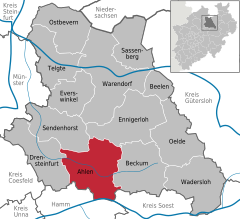|
Ahlen
Ahlen (German pronunciation: [ˈaːlən] ⓘ; Westphalian: Aulen) is a town in North Rhine-Westphalia, Germany, 30 km southeast of Münster.[3] Ahlen is part of the District of Warendorf and is economically the most important town in that district.[citation needed] Ahlen is part of the larger Münster region, and of the historic Münsterland area. The nearby villages of Dolberg, Vorhelm and Tönnishäuschen are part of Ahlen, as well. The largest neighboring town is the city of Hamm to the southwest. GeographyNeighbouring townsSurrounding Ahlen are the towns of Sendenhorst, Ennigerloh, Beckum, Lippetal, Heessen (District of the city of Hamm) and Drensteinfurt. Town districts
Outlying villagesHistoryEarly times   The first recorded mention of Ahlen is in the Vita Liudgeri, dating to about the year 850. The reason for the name, which means "eels", are unknown. An eel bedecked with a crown and feathers is on the town's coat of arms. The start of settlement was likely due to there being a crossing over the river Werse, which was also the crossing of two key roads (Hamm–Ahlen–Warendorf and Beckum–Ahlen–Herbern), and the beginning of a third road (Ahlen–Münster). In its early centuries, the fledgling settlement was built around an episcopal court. Within the safe haven of this church fortification, the first settlers were craftsmen and merchants who traded with the local farmers and peasants of the court. Long-distance trading started in the second half of the 12th century — proof being the names of Ahlen merchants found on invoices from merchants in Lübeck. Ahlen was also part of the north German Hanse. During this time a town wall with five towers was built (about 1271). The stripping away of the town wall had begun in the year 1765 and the last hint of it was gone by 1929. Ahlen grew quickly during the 13th century and in or about the year 1285, the population was so high that a new church (St. Marien) was founded next to the old one (St. Bartholomäus). This leads to the likelihood that Ahlen was one of the 18 biggest towns in Westphalia, at that time. However, the town's growth was hindered in the 14th century by the Black Death. According to the town's census book of 1389, only 63 families were left in Ahlen. But the town rebounded. In 1454, a citizen list showed 212 families living in Ahlen; seven noble families and their attendants lived in the episcopal court as well. Based on this number of families, a calculated population estimate of 1,300 citizens would be realistic. By this time the town had four quarters — all of which being about the same size and each quarter being named after its own town gate. Each quarter was responsible for defending its part of the town wall and gate. During the 16th century, there were three plague epidemics in 1505, 1551 and 1592; leprosy also killed many people. In the year 1571, the mayor and the council decided to build a special hospital for leprosy. Disastrous fires in 1483, 1668 and 1744 were responsible for further halting Ahlen's growth. About 20 documents of witch trials during the time from 1574 until 1652 survive. The hunt for witches started in 1574 with the death of four women. Thereafter, Peter Kleikamp was charged with being a werewolf; he was tortured and burned alive on the pyre. In 1616, Christian zum Loe was charged with wizardry; he went insane and died while in jail. The last known case was in 1652 against Anna Sadelers; she was tortured, burned alive on the pyre and beheaded. National Socialism and World War IIIn 1938 the people of Ahlen destroyed the Ahlen synagogue. By November 1938, there were no more Jews in Ahlen.[4] PoliticsTown Council
Coat of armsBlazon: “In red, a gold crowned, inwardly curved, seven-fold winged silver eel. Above the coat of arms a three-tower wall crown with gate. ”The oldest seal shows the pious eel in the city gate, above it Saint Bartholomew. This saint is the patron saint of Ahlen. The seal has appeared since the 13th century: Certificate v. May 21, 1255 - "The city of Ahlen enters into a state of peace with the city of Cologne". Since the 17th century, only the eel has been represented, both in the city coat of arms and in the seal. In its current form, the coat of arms was awarded by the Prussian state on December 5, 1910.[5] Mayors1809–1945
Honorary Mayors 1946–1996
Full-time Mayors since 1996
Town Directors/Main Civil Servants
Economy and AdministrationOne of the best known companies in Ahlen is Franz Kaldewei GmbH & Co. KG, one of the biggest bathtub manufacturers worldwide. Also well known is LR Health & Beauty Systems,[7] which was bought by Apax Partners in 2004. TransportAhlen station is on the Hamm–Minden railway and is served every hour by the Rhein-Weser-Express and the Ems-Börde-Bahn. EducationElementary schools
Secondary Modern Schools
Junior High School (ages 10 to 16)
The Sekundarschule and TMG used the building of the former Realschule High schools
Comprehensive School
Special Needs School
Vocational Schools
Places of interestBuildings
Museums
Clubs
EconomyAhlen's economy was dominated by the coal industry for nearly one century. Twin towns – sister cities
Ahlen is a member of the Hanse.[clarification needed] Notable people
References
External links
|
||||||||||||||||||||||||||||||||||||||||||||||||||||||||||||||








